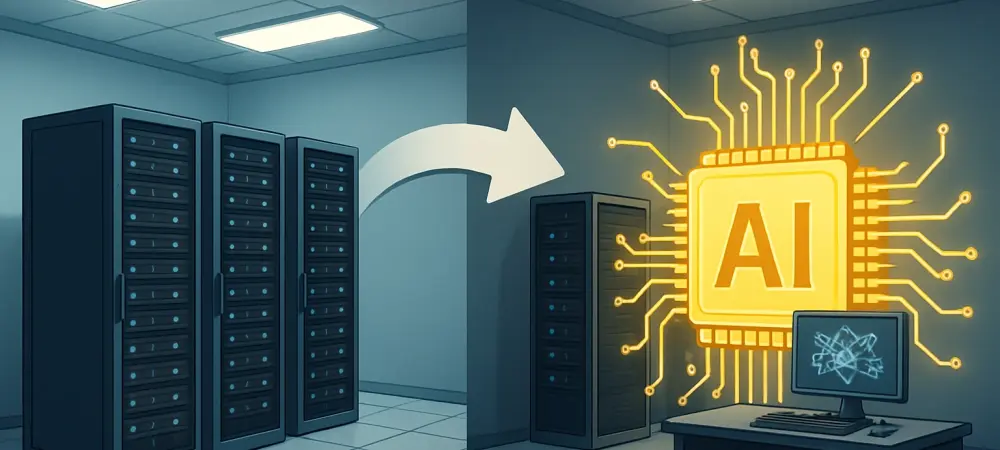Setting the Stage: A Power-Hungry Digital Revolution
Imagine a world where every AI-driven innovation, from autonomous vehicles to personalized healthcare, hinges on the silent workhorses of technology—data centers. These facilities, often hidden from public view, are now at a critical juncture as artificial intelligence surges, demanding unprecedented computational power. This market analysis explores how the data center industry is being reshaped by four pivotal forces—Power, Pace, People, and Perception—amid an AI boom that shows no signs of slowing. With energy consumption soaring and infrastructure stretched thin, the stakes have never been higher. This examination aims to uncover current trends, forecast future challenges, and provide strategic insights for stakeholders navigating this rapidly evolving landscape.
Diving into Market Dynamics: Trends and Forecasts
Power: The Energy Bottleneck Threatening Growth
The data center market faces a monumental challenge with power consumption, as AI workloads drive electricity needs to historic highs. Industry hubs like Northern Virginia, which house a significant portion of global capacity, are grappling with grid limitations due to outdated transmission infrastructure and heavy reliance on imported energy. Market projections indicate that without substantial investment in scalable energy solutions, such as microgrids or renewable sources, blackouts and operational disruptions could become commonplace by 2027. The trend toward sustainability is gaining traction, with some operators piloting solar and wind integration, though scaling these solutions remains a hurdle given the immediate demands.
Beyond renewables, there is a noticeable shift toward exploring advanced battery storage to mitigate peak load issues. However, the capital costs and regulatory barriers associated with these technologies are slowing adoption rates. If unaddressed, this energy crisis could stifle AI innovation, impacting sectors reliant on real-time data processing. The market must prioritize partnerships with utility providers to modernize infrastructure, as failure to do so risks significant economic fallout across dependent industries.
Pace: Accelerating Builds to Match AI’s Urgency
Another defining trend is the accelerated pace of data center construction, driven by the urgent need to support AI’s rapid adoption. Traditional building timelines, often spanning several years, are no longer viable as tech giants and startups alike demand immediate capacity. Market analysis reveals a growing reliance on modular and prefabricated construction techniques, which can reduce build times by up to 30%. This shift, while promising, introduces concerns over quality control and long-term durability, especially in regions prone to environmental stressors.
Looking ahead, the forecast from 2025 to 2027 suggests that the market will see intensified competition to secure land and resources for quick-turnaround projects. This rush could lead to oversaturation in key areas, potentially driving up costs and straining local ecosystems. Balancing speed with sustainability will be critical, as stakeholders must adopt innovative design practices to meet demand without compromising future scalability. The pace of development is not just a logistical issue but a competitive one, with global players watching closely for any signs of lag.
People: The Talent Shortage Undermining Expansion
A less visible but equally pressing trend is the talent shortage plaguing the data center sector. From skilled electricians to strategic planners, the industry faces a deficit of qualified personnel, exacerbated by an aging workforce and limited influx of new entrants. Current market data highlights a growing gap, with estimates suggesting that unmet staffing needs could delay projects by months, impacting overall capacity growth. This issue extends beyond technical roles, affecting administrative and cybersecurity functions vital to operational security.
Projections indicate that without aggressive workforce development initiatives, such as apprenticeships or reskilling programs for displaced workers from other sectors, the talent crunch could worsen over the next few years. There is an emerging trend of companies partnering with educational institutions to build pipelines for young talent, though these efforts are still in early stages. Addressing this human capital challenge is essential not only for maintaining growth but also for ensuring the resilience of critical digital infrastructure in an AI-driven economy.
Perception: Community Resistance as a Market Risk
Public perception represents a unique market risk, as local opposition to data center expansion grows due to concerns over noise, density, and environmental impact. In regions like Loudoun County, community pushback has delayed projects, reflecting a broader trend of skepticism toward the industry’s footprint. Market analysis shows that negative sentiment can directly affect regulatory approvals and project timelines, with some areas imposing stricter zoning laws in response to resident concerns.
Forward-looking insights suggest that perception management will become a key differentiator for operators. Transparent communication, emphasizing economic benefits like job creation and infrastructure funding, is gaining importance as a strategy to build trust. The market is likely to see increased investment in community engagement initiatives over the next few years, as companies recognize that social license is as critical as technical capacity. Failure to address this trend could result in costly delays or even project cancellations, reshaping investment patterns in affected regions.
Reflecting on the Path Traveled: Strategic Takeaways
Looking back, this analysis delved deeply into how the data center market adapted under the strain of AI’s meteoric rise, with the Four Ps—Power, Pace, People, and Perception—emerging as defining challenges. Each factor revealed unique vulnerabilities, from energy constraints that threatened operational stability to talent shortages that slowed expansion. Community resistance added another layer of complexity, often halting progress before it even began, while the relentless pace of construction tested the industry’s capacity for innovation. The interconnected nature of these issues became evident, as solving one often required addressing the others simultaneously.
For stakeholders, the journey underscored the need for integrated strategies that went beyond short-term fixes. Moving forward, actionable steps included forging alliances with energy providers to secure sustainable power sources and investing in modular construction to maintain speed without sacrificing quality. Equally important was the focus on building a robust workforce through targeted training programs and reshaping public narratives through genuine dialogue with communities. These efforts, if sustained, promised to transform challenges into opportunities, positioning the data center market not just to survive but to thrive in an AI-dominated future.

